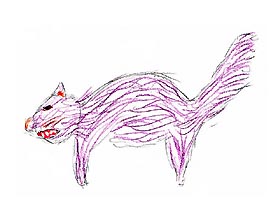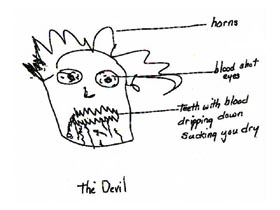|
This is an archived article.
For the latest news, go to the Advance
Homepage
For more archives, go to the Advance Archive/Search Page. |
|||||
|
Nursing Professor Says AIDS
Patients'
Drawings A Useful Assessment Tool By Sarah Breckenridge A grave adorned with red and white flowers lies beneath a darkened sun. The headstone reads "RIP sister and daughter." The image is a patient's representation of what happened to her after being diagnosed with AIDS. The red and white flowers represent love and purity, and their green stems, a world of living things. The sun is concealed by a black cloud, which represents the sadness of the patient's family.
The picture is one of the illustrations collected by Elizabeth Anderson, an assistant professor of nursing, during a recent research project on quality of life and coping strategies among AIDS patients. Anderson interviewed 58 men and women with AIDS from a long-term care facility and AIDS clinic in Connecticut, and asked some of them to draw and discuss images of their perception of AIDS. She divided the images into two categories, one negative and one positive. The first was based on patients' depictions of AIDS as an overpowering, inescapable force that devours any hope of life. These patients experienced a poorer quality of life and greater mood disturbance. They described AIDS as "a curse" or "a skeleton crying." One patient drew AIDS as an angry beast. The creature was purple, reminiscent of bruising, and had red teeth representing destruction. Another patient drew a devil with many horns, bloodshot eyes, and bloody teeth. The teeth were described as "sucking you dry." A third patient drew herself lying on a stretcher surrounded by her husband and seven children. In captions she wrote that she was experiencing pain from head to toe, hair loss, weight loss, the inability to eat or move, and an overwhelming sense of loneliness. She said that although her family continued to love her, she felt unable to love them back. In the second category, patients viewed AIDS as a challenge or danger that needs to be faced and fought daily. One patient described AIDS as a wild cat that could be kept at bay as long as he was attentive. If he didn't maintain his grip, the wild cat would reach out and scratch him. Another of the more optimistic patients colored a three-tiered timeline of red, blue, and yellow. The red segment of the timeline symbolized the distraught period directly following diagnosis; the blue segment, the period of treatment and medication; and the yellow segment, a period of hope. A third patient drew a frowning face, with a caption underneath that read, "I feel sad, but deep down inside of me I believe there is going to be a cure." Currently, Anderson is completing another study of people with HIV/AIDS, focusing on the effects of nausea, self-efficacy, and relationships with health care providers on medication adherence. She asked all individuals in this study to draw images of the disease. Anderson hopes that these pictorial representations of AIDS will help nurses assess patients' ability to cope and identify those who need further assistance. She recommends that art be regularly considered as a method for assessing how a patient feels about having AIDS. Anderson also believes that the process of imaging AIDS is itself helpful to patients, as it provides them with an opportunity for reflection and self-discovery. |



